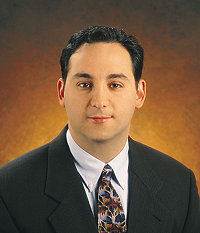 Regrowth: First off, please give us some background information about yourself and your practice. What is your medical background and how long have you been practicing?
Regrowth: First off, please give us some background information about yourself and your practice. What is your medical background and how long have you been practicing?
Dr. Ziering: I am Board Certified in Dermatology and Hair Transplants. I practice exclusively hair transplants primarily in Oak Brook, Illinois. I am the Associate Medical Director of Medical Hair Restoration and have been performing hair transplants since 1990.
Regrowth: Do you prescribe Propecia to your patients and if so do you find its effects match the results of the clinical studies?
Dr. Ziering: Yes I do prescribe Propecia to my patients and I find its effects to perhaps be a bit better then the results in clinical studies.
Regrowth: What do you say to people that are concerned about the side effects of Propecia?
Dr. Ziering: I personally have been taking Propecia for >1 year without any side effects. Side effects were found in <2% and only ½ % difference from the control group. Furthermore, 60% of patients experiencing side effects had them resolve after 4 months with continued therapy and all resolved if Propecia was discontinued.
Regrowth: Do you ever prescribe Propecia to women who are not planning to have children or past their childbearing years? If so, how effective has it been for them?
Dr. Ziering: Yes, I do prescribe Propecia to woman in these circumstances with counseling and after all therapeutic options have been exhausted.
Regrowth: Have you heard reports from any patients on Propecia of excessive shedding of hair and what results do these patients generally end up having?
Dr. Ziering: The only reports of shedding that I have heard of have been of patients who have discontinued the use of Propecia. They typically loose the hair they had gained within 12 months of stopping Propecia.
Regrowth: Have you ever had patients using Propecia who it was effective for initially but then lost its effectiveness?
Dr. Ziering: No, I have patients who have reached a plateau on Propecia and those who have had no results but not any yet who it has lost effectiveness.
Regrowth: Do you prescribe Proscar to your patients who want to get on Finasteride but want to save money by quartering Propecia pills?
Dr. Ziering: No, for two reasons: without the protective coating there is the risk of transcutaneous absorption and secondly when the pill is formulated the active ingredient is not evenly distributed throughout the pill. Dividing the pill in quarters does not mean proper dosing. For example, it is possible to be getting 4mg on day 1, 0 on day2 & 3 and then 1mg on day 4.
Regrowth: What percentage of your patients using Propecia would you say experience side effects?
Dr. Ziering: About 2% of my patients report side effects.
Regrowth: Do you recommend Rogaine Extra Strength / Minoxidil 5% to your patients?
Dr. Ziering: Yes I do.
Regrowth: Do you find Minoxidil 5% provides additional results over Minoxidil 2%?
Dr. Ziering: Yes I do.
Regrowth: How do you feel about higher strength Minoxidil formulas of up to 15% that can be obtained via a prescription through custom compounding pharmacies? Do you think they will provide additional results?
Dr. Ziering: More is not necessarily better. With all medications, there is a strength for maximum effectiveness beyond which all that increases is the potential for side effects. I have not done studies to determine that dose for Minoxidil but I believe 5% is close to that threshold.
Regrowth: Have you prescribed Minoxidil 5% to many woman and is so how effective was it?
Dr. Ziering: To some woman 5% seems to be slightly more effective than 2% however, some women may get facial growth with the 5% concentration.
Regrowth: Have you seen any or many woman using Minoxidil (2% or 5%) who had the side effect of unwanted facial or body hair growth?
Dr. Ziering: Yes, particularly facial hair growth with 5%.
Regrowth: What do you think of the claim of the woman who is suing Upjohn saying Minoxidil caused unwanted facial growth that didn’t go away after treatment was discontinued?
Dr. Ziering: I find this hard to believe based on my experience.
Regrowth: Do you find patients using both Propecia and Minoxidil 5% have better results than patients using either alone?
Dr. Ziering: Yes, particularly in my own personal situation.
Regrowth: What is the largest improvement you have seen in someone taking Propecia alone (on the Norwood scale)?
Dr. Ziering: From a Norwood 4 to a Norwood 3.
Regrowth: What is the largest improvement you have seen in someone using Minoxidil 5% alone (on the Norwood scale)?
Dr. Ziering: From a Norwood 4 to a Norwood 3, but in general Propecia seems to have a more positive effect for more patients.
Regrowth: What is the largest improvement you have seen in someone using both Minoxidil 5% and Propecia (on the Norwood scale)?
Dr. Ziering: From a Norwood 5 to a Norwood 4.
Regrowth: Have you heard success stories with any other products available for hair loss, such as Tricomin, Folligen, Fabao, Kevis, etc.? If so what results were reported?
Dr. Ziering: I have heard claims of success stories however, I have not substantiated them and these successes may be patients with Alopecia Areata or Tellagon Effluvium and not Alopecia.
Regrowth: What do you tell people for whom Minoxidil 5% and Proscar is ineffective who don’t wish to have transplants or use a hair system?
Dr. Ziering: I tell them that beauty is in the eye of the beholder and suggest various styling techniques or accents to help restore ones focus to the central face.
Regrowth: How long have you been performing transplants and how many do you estimate you have performed (patients and procedures)?
Dr. Ziering: I began performing transplants in 1990. I currently do exclusively hair transplants between 60-80 procedures per month.
Regrowth: Do you see many women for transplant operations, and is this number increasing?
Dr. Ziering: Women make up about 5% of my practice and this seems to be increasing in recent years.
Regrowth: Are women more or less suited to transplants than men?
Dr. Ziering: Each patient must be evaluated for suitability individually based on factors such as their expectations, current pattern of loss and donor density. As a rule, a transplant for a female patient can be more challenging since their loss is most commonly diffuse while males are most commonly discrete.
Regrowth: We hear so many different terms for grafts from different practices. Which grafts do you perform and why? Do you transplant only follicular units?
See below.
Regrowth: How many hairs or grafts do you transplant in one session?
Dr. Ziering: I average 800 grafts per session.
Regrowth: Do you believe in the mega-sessions method of transplanting large numbers of hairs all in one session?
Dr. Ziering: I often do sessions in the 1000-1400 graft range, but much beyond that is often less than optimal for the patient and staff.
Regrowth: How many transplant sessions does your average patient go through?
Dr. Ziering: My patients average 2 to 3 sessions.
Regrowth: Some practices offer guarantees that their grafts won’t fall out and if they do that, they will replace them. Do you offer any such guarantees, and how could you tell if any of their grafts fell out anyway?
Dr. Ziering: This is a rare occurrence, but if a patient states that they lost a graft, it is replaced without question.
Regrowth: Do you have any idea what percentage of your patients would say they are satisfied with their results once they are finished?
Dr. Ziering: I would say 95-99% are satisfied. We must remember that a patients’ perception is their reality and there are limitations to the results based on available donor and personal finances.
Regrowth: Do you ever turn patients down who seem to have psychological problems regarding their hair loss? What percentage of patients are these?
Dr. Ziering: Yes, but not often. Psychological problems regarding hair loss is not an automatic exclusion.
Regrowth: Do you ever turn patients down just because their amount of loss is too extensive for them to get good results? What percentage of patients?
Dr. Ziering: Rarely, I turn them down only if I feel I can’t match their expectations. Even a small amount of hair placed properly can dramatically change a person’s appearance.
Regrowth: Do you ever turn patients down who haven’t lost enough hair yet to know what their final amount of loss will be? What percentage of patients?
Dr. Ziering: Rarely. If I anticipate considerable loss in the future, I will be very conservative transplanting only the frontal 1/3 and I will spend a lot of time in consultation with the patient assessing his/her expectations and reviewing the likely progression of his/her loss.
Regrowth: How can a patient know when he has lost enough hair to make transplants worthwhile without worrying about further loss causing poor end results?
Dr. Ziering: Patient expectations, conservative approach over time, experience in surgery and thorough knowledge of the progressive nature of hair loss is important considerations in evaluating a patient with early loss. However if done properly early intervention can give a patient virtually undetectable results without suffering the psychological effects of early hair loss. When designing the recipient area for grafting, careful consideration must be given to tying into transitional zones of potential future hair loss.
Regrowth: What general guidelines do you look for to tell if someone has enough hair left to have a transplant?
Dr. Ziering: Most patients have enough hair in the donor area to undergo a transplant; the issues are what are their expectations and what density does their fringe hair have that they are trying to match.
Regrowth: How painful are the shots to the scalp for local anesthetic?
Dr. Ziering: With our technique, there is minimal discomfort.
Regrowth: How noticeable is the surgery immediately afterwards? How soon can someone go out in public without it being obvious that they’ve had the surgery?
Dr. Ziering: This is the most dependent on the size grafts used and amount of existing hair available for camouflage. Often my patients can return to work the next day however, scabs on larger grafts can be present for up to 10 days.
Regrowth: Several people have posted that transplant doctors have told them that transplants would not cause any existing hair to fall out and then it did. Do you warn patients of this and how frequent is it? Are these hairs that have gone into resting phase due to trauma of surgery and will grow back or are they MPB affected hairs that have fallen out early due to surgery and will not grow back?
Dr. Ziering: Existing hair can fall out after surgery and whether it returns or not depends on if the hairs were programmed to fall out anyway (MPB). These hairs are weak and have a shortened anagen growth phase and if the transplants are in close proximity to these hairs they will fall out and likely not return. However, if a tellagen effluvium occurs (resting phase due to trauma of surgery) then the hairs will most likely return. Incidentally, I have found the “Graftcyte” seems to diminish the fall out effect.
Regrowth: Have you evaluated ProCyte’s GraftCyte moist dressings for preventing newly transplanted hairs from falling out and going into resting phase? Have you used them at all and what have been the results? If you haven’t used them do you plan to evaluate them?
Dr. Ziering: Yes I have used these dressings in over 500 patients and have found them very beneficial in preventing newly transplanted hairs from falling out and going into resting phase.
Regrowth: Do you recommend Propecia/Proscar and/or Minoxidil to transplant patients?
Dr. Ziering: I recommend Propecia and/or Minoxidil when appropriate.
Regrowth: If someone uses Minoxidil and has a transplant session, how soon can they start using Minoxidil again after the surgery?
Dr. Ziering: Three to five days following surgery.
Regrowth: Do you recommend any topical treatments such as Iamin or GraftCyte after surgery to promote healing of the grafts?
Dr. Ziering: I have used Procytes Graftcyte kit in over 500 patients and now recommend it to all my patients as a result of my witnessing many beneficial results from its use.
Regrowth: What do you do if a patient comes back to you and is unhappy with their transplants results?
Dr. Ziering: This is an extremely rare occurrence however a patient’s perception is their reality. If the surgery does not live up to the patient’s expectations, we might do a subsequent procedure at a reduced cost.
Regrowth: What do you think of laser hair transplantation? What are the advantages and disadvantages? Is this just a gimmick to get people who think, “if it’s lasers it must superior”?
Dr. Ziering: I have performed laser transplant surgery as well as worked on the research and technical innovation for this method. I have found this to be another way to create recipient sites. It may have some tremendous benefits in the future however; currently this is being used more as a marketing ploy rather than a true aesthetic advancement.
Regrowth: What do you think of the idea of culturing unlimited amounts of hair for transplantation? When do you think this will be a reality?
Dr. Ziering: The idea is great because it provides hope for patients without or limited donor however the challenge is to be able to culture strong terminal hairs. They will still need to be transplanted in an aesthetic fashion.
Regrowth: What other advances do you see in the future for transplant surgery and how soon do you think they will be available?
Dr. Ziering: I think there will be continued improvement in the effectiveness of medications used to block the effects of DHT with decreased side effects.
Regrowth: Do you perform scalp reductions and if so how many would you say you have performed?
Dr. Ziering: I rarely perform them currently but I have probably performed several hundred in the past.
Regrowth: Speaking of scalp reductions, most doctors will not perform them and some places claim they are unnecessary due to advances in grafting techniques for transplants. Why do you perform scalp reductions and who is right?
Dr. Ziering: With todays techniques I find virtually no indications in which my patients would opt for this procedure in addition or in place of grafting.
Dr. Craig Ziering, Medical Hair Restoration
120 Oakbrook Center Mall #208
Oakbrook, IL 20523
630-368-9700
The following is Dr. Ziering’s article explaining the types of grafts he uses and how he uses them.
Follicular Unit and Micro-Mini Grafting Techniques
Dr. Craig Ziering
The nomenclature for different types of grafts is very confusing. I personally perform all types of grafts, both follicular unit grafting and micro-mini grafting. It is important that a patient understands the surgeon’s definition of these grafts and in that way, he or she can compare the various techniques. My definition of a micro-graft is using follicular units as they occur naturally in each patient’s donor area. For example, in a given patient he or she may have a follicular unit that consists of one, two or three hairs and rarely four. I use micro grafts as a term to categorize all of these types of follicular unit grafts. With my technique the follicular units are always preserved as they naturally occur. In appropriate patients, I will also use a mini-graft. My definition for a mini-graft is an artificial designation of the recipient site size by the surgeon in which families or groups of follicular units are kept together and placed “en-block” into the recipient site hole. In most instances my mini-grafts are 1.5 mm in size. This usually consists of two follicular unit groups. On rare occasions, with light colored hair, I may use a 2 mm mini-graft which would have two to three follicular unit families grouped together. Furthermore, if these families where spaced too far apart in the donor area, with too much tissue in between the follicular units, then I would not use this technique on this patient. The goal of any hair transplant procedure is to provide the patient with a very natural look, maintaining virtually undetectable results and giving them as much density as possible without compromising the first two points. Multiple techniques can be effective for all patients, however it is the job of the surgeon to select the best method to obtain each patients specific objective. It is important to evaluate the density and availability of the donor area, the quality and quantity of each patients follicular units, as well as the proximity of naturally occurring neighboring follicular unit families. My harvesting technique for both follicular units and mini-grafts involve the removal of a single strip with dissection of appropriate size and type of grafts performed under magnification and back lighting. There is always preservation of follicular units thus maximizing donor supply. In summary, it is important for my patients to understand that with my techniques I use follicular units alone or in combination with mini-grafts, based on a patients skin and hair color, caliper and texture, as well as current and expected hair loss to achieve maximum aesthetic results.





